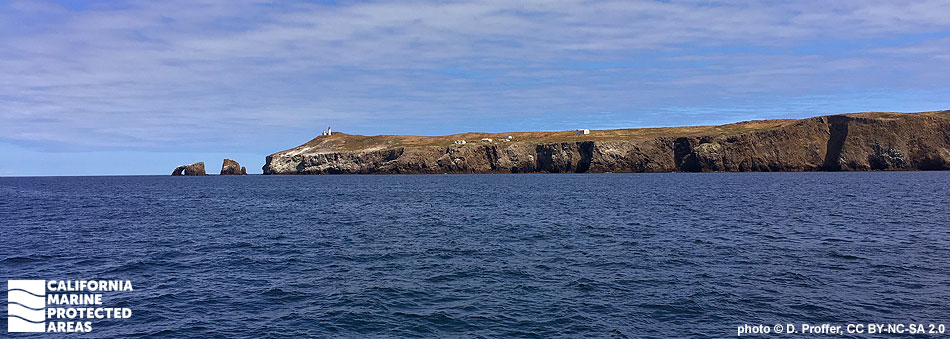
Overview
Anacapa Island is the Channel Island situated closest to the mainland, just 12 miles from Oxnard Harbor. The island is really three large islets named East, Middle, and West Anacapa that are situated more or less end-to-end like beads on a string. Together these islets make up Anacapa Island, which is nearly five miles long. The rugged island features wave-eroded volcanic shores, towering sea cliffs, caves, and natural bridges, including the 40-foot-high Arch Rock, an iconic symbol of Channel Islands National Park.
On the northern side of Anacapa Island are four marine protected areas (MPAs) known as Anacapa Island State Marine Reserve (SMR), the federal Anacapa Island Marine Reserve (FMR), Anacapa Island State Marine Conservation Area (SMCA) and the federal Anacapa Island Marine Conservation Area (FMCA), along with Anacapa Island Special Closure, which encircles the entire island.
Anacapa Island SMR encompasses more than 11½ square miles of state waters, and Anacapa Island SMCA over seven square miles. The SMR and SMCA protect sandy beaches, extensive rocky shores, surfgrass beds, kelp forests, and deep offshore sand and rocky seafloor to depths greater than 700 feet and 450 feet, respectively. Where the SMR and SMCA end at three nautical miles from shore, the FMR and FMCA continue farther offshore to the boundary of the Channels Islands National Marine Sanctuary.
Anacapa Island Special Closure surrounds all three of the islets and overlaps a portion of both the SMR and the SMCA. The special closure covers a little more than one square mile, and its main purpose is to protect breeding brown pelicans and their fledglings from human disturbance. The special closure includes a brown pelican fledgling area that is closed annually from January 1 to October 31.
Special closures are designed to minimize disturbance of seabirds and marine mammals by restricting boating and access, seasonally or year-round. This special closure prohibits the use of nets and traps in waters less than 20 feet deep, and seasonally bans boating activity and access in waters within the brown pelican fledgeling area.
Species protected within the lush kelp forests spanning the MPAs and special closure include: California sheephead, garibaldi, bat rays, moray eels, horn sharks, leopard sharks, California sea lions, harbor seals, sea stars, kelp bass, sheep crab, brightly colored nudibranchs (sea slugs), and giant sea bass, among many others. Onshore, the rocky cliffs are surrounded by the special closure, which limits access to protect one of the world’s largest breeding colonies of California brown pelicans.
Regulations
Anacapa Island SMR
It is unlawful to injure, damage, take, or possess any living, geological, or cultural marine resource.
California Code of Regulations Title 14, Section 632(b)(113)(opens in new tab)
Note: The state and federal marine reserves share identical regulations.
Anacapa Island SMCA
It is unlawful to injure, damage, take, or possess any living, geological, or cultural marine resource, EXCEPT:
Recreational take of lobster and pelagic finfish (northern anchovy, barracudas, billfishes, dorado (dolphinfish), Pacific herring, jack mackerel, Pacific mackerel, salmon, Pacific sardine, blue shark, salmon shark, shortfin mako shark, thresher shark, swordfish, tunas, Pacific bonito, and yellowtail) is allowed. Commercial take of lobster is allowed. Includes take exemptions for the following tribe:
- Santa Ynez Band of Chumash Indians
California Code of Regulations Title 14, Section 632(b)(112)(opens in new tab)
Note: The state and federal marine conservation areas share identical regulations.
Anacapa Island Special Closure
No net or trap may be set in waters less than 20 ft deep off Anacapa Island.
20 fm (120 ft) brown pelican fledgling area closed Jan 1-Oct 31. No person except employees of the California Department of Fish and Wildlife or the National Park Service during the performance of their official duties shall enter this area during the closure period. See CCR T14 §632(b) (link below) for details.
California Code of Regulations Title 14, Section 632(b)(111)(opens in new tab)
Quick Facts
These facts are for the state marine reserve, state marine conservation area, and special closure only.
Anacapa Island SMR
MPA size: 11.55 square miles
Shoreline span: 3.1 miles
Depth range: 0 to 709 feet
Habitat composition*:
- Rock: 0.38 square miles
- Sand/mud: 11.15 square miles
Anacapa Island SMCA
MPA size: 7.30 square miles
Shoreline span: 2.2 miles
Depth range: 0 to 490 feet
Habitat composition*:
- Rock: 0.14 square miles
- Sand/mud: 6.78 square miles
Anacapa Island Special Closure
Special Closure size: 1.03 square miles
Depth range: 0 to 124 feet
Habitat composition*:
- Rock: 0.44 square miles
- Sand/mud: 0.53 square miles
*Habitat calculations are based on three-dimensional area and may exceed the total MPA area listed above.